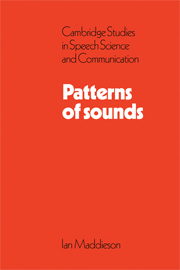Book contents
- Frontmatter
- Contents
- Dedication
- Preface
- 1 The size and structure of phonological inventories
- 2 Stops and affricates
- 3 Fricatives
- 4 Nasals
- 5 Liquids
- 6 Vocoid approximants
- 7 Glottalic and laryngealized consonants
- 8 Vowels
- 9 Insights on vowel spacing
- 10 The design of the UCLA Phonological Segment Inventory Database (UPSID)
- Appendix A Language lists and bibliography of data sources
- Appendix B Phoneme charts and segment index for UPSID languages
- Frontmatter
- Contents
- Dedication
- Preface
- 1 The size and structure of phonological inventories
- 2 Stops and affricates
- 3 Fricatives
- 4 Nasals
- 5 Liquids
- 6 Vocoid approximants
- 7 Glottalic and laryngealized consonants
- 8 Vowels
- 9 Insights on vowel spacing
- 10 The design of the UCLA Phonological Segment Inventory Database (UPSID)
- Appendix A Language lists and bibliography of data sources
- Appendix B Phoneme charts and segment index for UPSID languages
Summary
Introduction
Vowels are discussed in two chapters in this book. In the present chapter we will deal with questions of which vowels are most frequent in the world's languages and how many vowels are typically found. A brief discussion of diphthongs is also included. In the following chapter, contributed by Sandra F. Disner, the focus is on the structure of vowel systems.
Types of vowels
The entire UPSID database contains entries for 2549 monophthongal vowels, that is, a mean of fractionally over 8 for each language. In addition there are 83 diphthongal segments included, making a total of 2632 vocalic segments. In the following sections, we will describe the most frequent types of vowels and comment on some of the implications.
The three conventional parameters for vowel description are those of vowel height, backness, and lip-rounding. In the UPSID data file, vowels are classified as having one of five different heights, high, higher mid, mid, lower mid, or low. Vowels described as being mid may in fact lie between higher and lower mid positions, or they may have simply been transcribed or labeled as mid vowels without any further specification in the source consulted for the language in question. In either case, such vowels are distinguished notationally from higher mid vowels by being enclosed in double quote marks, i.e. /e/, /φ/, and /o/ represent higher mid vowels, but /“e”/, /“φ”/, and /“o”/ represent mid vowels.
- Type
- Chapter
- Information
- Patterns of Sounds , pp. 123 - 135Publisher: Cambridge University PressPrint publication year: 1984

